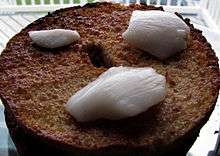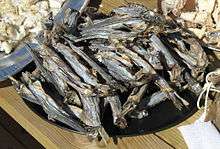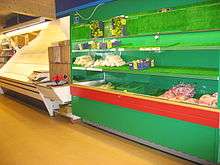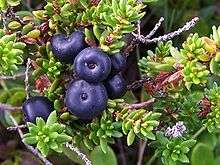Greenlandic cuisine

Greenlandic cuisine is traditionally based on meat from marine mammals, game, birds, and fish, and normally contains high levels of protein. Since colonization and the arrival of international trade, the cuisine has been increasingly influenced by Danish and Canadian cuisine.[1] During the summer when the weather is milder, meals are often eaten outdoors.[2]
National dish
The national dish of Greenland is suaasat, a traditional Greenlandic soup.[3] It is often made from seal, or from whale, reindeer, or seabirds. The soup often includes onions and potatoes, and is simply seasoned with salt and pepper, or bay leaf. The soup is often thickened with rice, or by soaking barley in the water overnight so that the starches leach into the water.
Seafood

Because the majority of Greenland is covered by permanent glaciers, the sea is the source for most food.[4] Seafood dishes include various fishes (often smoked), mussels, and shrimp. Ammassat or capelin, a fish in the salmon family is commonly eaten[2] and can easily be dried. Atlantic halibut, redfish, deepwater redfish, Greenland halibut, and lumpfish are fished from the west coast, as are Greenland cod (Gadus ogac) and shorthorn sculpin (Myoxocephalus scorpius), but these two are eaten only as a last resort.[5] Arctic char is fished off the east coast. The Greenland shark (Somniosus microcephalus) is rarely eaten because it is poisonous but can be edible after a complicated preparation[6] of either boiling the meat repeatedly or fermenting the meat.
Global warming has shifted the migration of Atlantic cod, allowing for commercial fishing off Greenland's east coast. Drift ice can create problems during fishing season, and the Danish government has not invested in large-scale fish processing plants.[7]
Sea mammals provide important staples to Greenlandic diets. A traditional Inuit specialty is mattak, a Greenlandic term for the raw hide of narwhal or white whale. Mattak can be prepared with blubber, and occasionally dried reindeer meat. When eaten raw, mattak is an important source of vitamin C.[8] Hunting hooded seals were traditionally an important annual social event as well as subsistence activity, which included men, women, and children.[7] Also popular is arfivik, or bowhead whale, smoked whale meat served with onions and potato. Dried cod and whale with whale blubber is a popular lunch and snack food.[2] Bearded and ringed seals are hunted year round, especially by Polar Inuit, while narwhals and white whales are hunting during the summer.[8] Subsistence whale hunting by indigenous peoples is legal, but some animal rights organizations are concerned about commercial whale hunting in Greenland, with one company, Arctic Green Food freezing and distributing a quarter of Greenland's whale meat.[9]
Meat
Land-based dishes include reindeer (caribou), lamb, mutton, and musk-ox, which can be served tartare.[10] Sheep farming and cattle ranching were introduced to Greenland by the Norse.[4] Caribou are hunted in the fall, foxes and hares year round, musk-oxen in the spring, and polar bear are hunted in the spring and fall.[8] Meats can be boiled, dried, frozen, fermented, or occasionally eaten raw. Caribou livers are consumed raw, immediately after the hunt.[8]
Fowl
Spring to fall is the season for hunting wild birds. The Polar Inuit hunt dovekie (Alle alle), eider, ptarmigan, thick-billed murre (Brünnich's guillemot or Uria lomvia), and a variety of sea gulls.[8] Additionally, kittiwake and ptarmigan are hunted on the east coast.[6] Sometimes wild eggs are gathered by hunters.[5]
Plants
Blueberries and crowberries (Empetrum nigrum), harvested in the autumn, often garnish cakes and other desserts.[2] Berry compotes accompany meat dishes.[10] Seaweed is stored as a reserve food for winter.[5] During the summer, roseroot (Sedum rosea), fireweed (Epilobium) leaves, and Greenland lousewort (Pedicularis groenlandica) are gathered.[6] Green vegetables are scarce but global climate change has slightly extended the growing season, so Greenlandic farmers are experimenting with new crops, such as broccoli.[10] Rice, potatoes, and onions are common starches in meals.
Seasoning and herbs
"Herbs have grown here for a thousand years,” says Anne Sofie Hardenberg, author, cook, and TV and radio personality. “The magical silence [of Greenland] is good for man, herbs, and animals." She is part of the locavore movement, which avoids Scandinavian influences in favor of local Greenlandic culinary traditions.[10] Angelica is a seasoning staple in Greenlandic cuisine.[10] Spices are used sparingly in Greenlandic dishes.
Beverages
Greenlandic coffee is a popular after-dinner drink. It typically features hot coffee, whiskey, Kahlúa, Grand Marnier, and whipped cream. Served in a bordeaux glass, the coffee is set on fire before drinking.[11]
Ice beer, that features 2000-year-old natural Arctic ice harvested from glaciers, was pioneered by the Greenland Brewhouse in Narsaq.[12] Currently, the Godthaab Bryghus, in Nuuk,[13] and Icefiord Bryghus, in Ilulissat,[14] brew with glacial water. Both crowberries and angelica are brewed into ales at the Icefiord Brewery.[10]
Until 1954, alcohol sales were heavily restricted in Greenland, so homebrewing is widely popular.[15]
Markets

Until 1980, animal foods comprised most of the Polar Inuit's diet, but grocery stores provide coffee, tea, biscuits, potato chips, and other foods.[8] The diversity of fresh fruit and vegetables varies greatly during the year. In periods where supplies can be delivered by ship (approximately May through November), the diversity is mostly better than in the winter period, where vegetables and fruit only can be delivered by plane.
See also
Notes
- ↑ "Greenlandic cuisine." Official Greenland Tourism Guide. (retrieved 30 Oct 2010)
- 1 2 3 4 "Traditional Greenlandic food." Official Greenland Tourism Guide. (retrieved 30 Oct 2010)
- ↑ "Recipes of Greenlandic Cuisine." Colonial Voyage. (retrieved 31 Oct 2010)
- 1 2 Kleivan, "Greenland Eskimo," 522
- 1 2 3 Kleivan, "West Greenland," 608
- 1 2 3 Petersen 631
- 1 2 Kleivan, "Greenland Eskimo," 523
- 1 2 3 4 5 6 Gilberg 582
- ↑ Black, Richard. "Greenland whale hunt 'commercial'." BBC News. 17 June 2008 (retrieved 31 Oct 2010)
- 1 2 3 4 5 6 "Extreme Eating in Greenland." creators.com (retrieved 10 Mar 2015)
- ↑ "Greenlandic Coffee." Official Greenland Tourism Guide. (retrieved 30 Oct 2010)
- ↑ "Greenland ice cap beer launched ." BBC News. 1 Aug 2006 (retrieved 31 Oct 2010)
- ↑ "Godthaab Bryghus." Tigm. (retrieved 30 Oct 2010)
- ↑ "Icefiord Bryggeri: Øltper." Hotel Icefiord. (retrieved 30 Oct 2010)
- ↑ Kleivan, "West Greenland," 609
References
- Gilberg, Rolf. "Polar Eskimo." David Damas, volume ed. Handbook of North American Indians: Volume 5, Arctic. Washington, DC: Smithsonian Institution, 1984: 577–594. ISBN 0-16-004580-0.
- Kleivan, Helge. "Greenland Eskimo: Introduction." David Damas, volume ed. Handbook of North American Indians: Volume 5, Arctic. Washington, DC: Smithsonian Institution, 1984: 522–527. ISBN 0-16-004580-0.
- Kleivan, Helge. "West Greenland Before 1950." David Damas, volume ed. Handbook of North American Indians: Volume 5, Arctic. Washington, DC: Smithsonian Institution, 1984: 595–621. ISBN 0-16-004580-0.
- Petersen, Robert. "East Greenland Before 1950. David Damas, volume ed. Handbook of North American Indians: Volume 5, Arctic. Washington, DC: Smithsonian Institution, 1984: 622–639. ISBN 0-16-004580-0.

